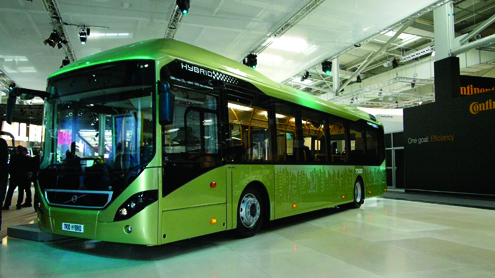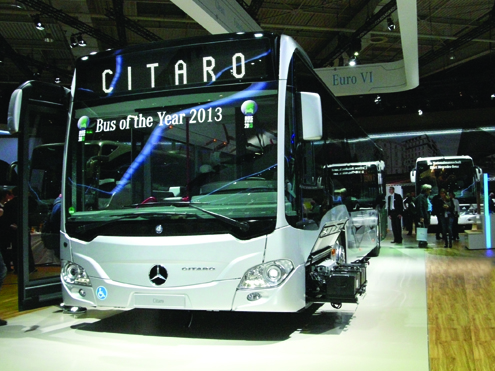
By Doug Jack

Every two years, the northern German city of Hannover stages the IAA Exhibition, which typically occupies several very large halls and covers all kinds of commercial vehicles and components. This year, while a very strong German industry dominated by Mercedes-Benz and MAN was present, there were exhibiters from around 50 countries with China and Turkey strongly represented.
Fuel economy and alternative energy were two recurring themes. All the major manufacturers exhibited engines to comply with Euro 6 emission limits that come into force in 2014. Mercedes-Benz can already offer Euro 6 engines in its new Citaro 2 city bus. Although the price is higher than the previous model, customers should benefit from superior fuel consumption and from higher residual values. Many more European cities are considering low emission zones which will effectively prohibit the use of older vehicles.
Most European manufacturers meet the Euro 6 limits by a combination of exhaust gas recirculation (EGR) and selective catalytic reduction (SCR). The latter process involves injecting urea into the exhaust system to virtually eliminate NOx. EGR systems require much larger radiators, typically adding around 300 pounds to the weight of a vehicle. This also leads to packaging problems on city buses where designers are trying to minimize the intrusion of the drivetrain into the passenger compartment.
Where designers have worked hard to save weight in their vehicles to offset the heavier cooling systems, there was a notable trend towards smaller engines to save weight and improve fuel economy. The most extreme was the decision of Volvo to fit a 5.1-litre engine in its next generation of double-deck chassis for the United Kingdom and Ireland.
It will be interesting to see how that concept can work in some of the hilly cities in the north of England. These vehicles are around 30 to 35 feet long on two axles. Volvo will use a larger and more powerful 8-litre engine in its tri-axle 40-foot double-deck buses for Singapore and Hong Kong.
The new Mercedes-Benz Citaro offers the option of a super-capacitor which sits in the battery compartment. This collects currents generated when the engine is on overrun to power electrically operated equipment, like the main doors. This can give a saving of 1 to 2 percent in fuel consumption, which adds up over a year.
Hybrids trend upward
Hybrid buses are now running in most European countries. They need the stimulus of government funding to bridge the difference in price compared with a standard diesel vehicle. However, with the upward trend in the price of diesel and the savings in consumption by the best systems, some operators are now looking at the purchase of hybrid buses.

Volvo said it had delivered or taken orders for more than 800 hybrid buses, mainly in Europe but also in Brazil and Mexico. The Swedish company made the very bold statement that with the introduction of Euro 6, it would only offer a hybrid driveline in its full low floor single deck transit bus.
Volvo will undertake a project in its home city of Gothenburg where hybrid buses will receive a fast boost of electricity at each end of a route. Volvo reckons that the vehicles will be able to operate up to 70 percent of the route solely on electrical energy.
Solaris of Poland had a 40-foot full low floor all-electric bus on its stand. The company reckons it will have a range of at least 150 miles on a full charge with the batteries topped off by fast charging during the day.
All-electric on display
An all-electric midi-bus was available for demonstration. On a circuit of the internal roads in the exhibition grounds, the acceleration was rapid, step-free and very silent. It was too fast for normal service and people milling around on the roads could not hear it coming.
There was a small outdoor area for demonstration of all kinds of electric vehicles. Bombardier had installed its Primove system in a very stylish transit bus built by the small German specialist, Viseon Bus. The Primove system is contactless and relies on electric charging plates beneath the surface of the road at busy bus stops and at other strategic points, like each end of the route. These plates or coils take their electrical charge from the main power grid through a convertor. When the bus comes to a stop above the charging point, electric current is passed quickly to a coil on the underside of the vehicle, giving the batteries a fast charge. It also means fewer batteries, saving weight and increasing capacity for passengers.
The Primove system is not confined to transit buses and could adapt to other suitably equipped electrically-driven vehicles that would pay for each charge of electricity. It might sound rather futuristic, but it could well be the shape of electric buses to come.
The Chinese are investing heavily in the development of more powerful batteries with extended range. One of them, Zhuhai Yintong Energy, acquired a bus manufacturer, Guangtong, so that it could build and promote complete all-electric vehicles. One was shown by an importer from the Netherlands who had successfully obtained certification under European regulations.
A
MZ-Kutno, a Polish company, showed an all-electric 35-foot midibus using lithium-ion batteries and electrical equipment by Cegelec, a Czech supplier. Their next development will be a full-size 40-foot bus using lithium-titonite batteries, originally developed for the U.S. military and said to have a 15 year guarantee.
Eurozone in crisis
The financial crisis in the Eurozone was another recurring topic of conversation. Generally speaking, demand for new buses and coaches remains quite strong in the Northern European countries, but sales have fallen sharply in Southern Europe, with Greece being extremely low.
In Northern Europe, demand for city buses and interurban vehicles is healthy. The main weakness is in high specification luxury coaches.
Smaller family companies who buy most of those are finding it more difficult to obtain bank financing. On the other hand, demand for express coaches is encouraging, as people look to get value for their money in these difficult times. SNCF, the French state railways, bought more than 40 coaches from Setra and Iveco to start international express services.
Germany touts express service
The German government has recently introduced legislation to deregulate long distance coach services. This will bring competition to Deutsche Bahn, the state railway company. A study by one of the German universities reckoned a demand for up to 4,000 express coaches over the next four to five years in Germany alone.
The challenge will be to establish a network, because there is no one obvious hub city. Munich, Frankfurt, Cologne, Dusseldorf, Hannover, Hamburg and Berlin are all major centres of population. Services might start first on routes which are not well served by the rail system, but where there are good highways (for example, between Stuttgart and Munich).
The German authorities have decreed that all express coaches must be capable of carrying at least two passengers in wheelchairs. One of the MAN exhibits was a high deck coach with a wheelchair lift behind the rear axle. People in wheelchairs are often vulnerable and must be apprehensive about being hoisted several feet into the air to be put on board a coach. It seems an archaic arrangement, compared with the very neat installing of wheelchair lifts in the main passenger entrance of express coaches in the United Kingdom. I
It’s not often that we can teach the Germans anything. BR
Doug Jack is with Transport Resources in the United Kingdom.

Seems like a great event!